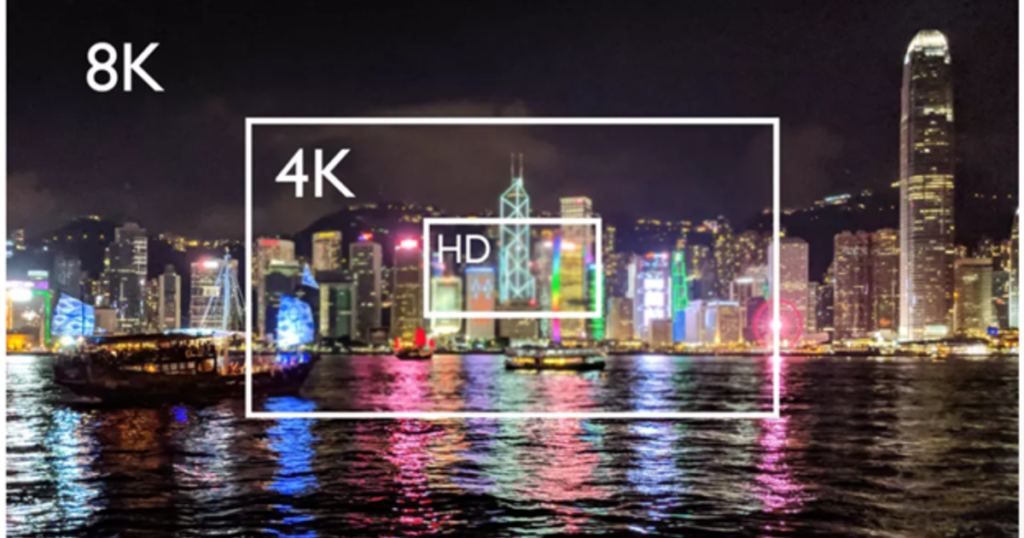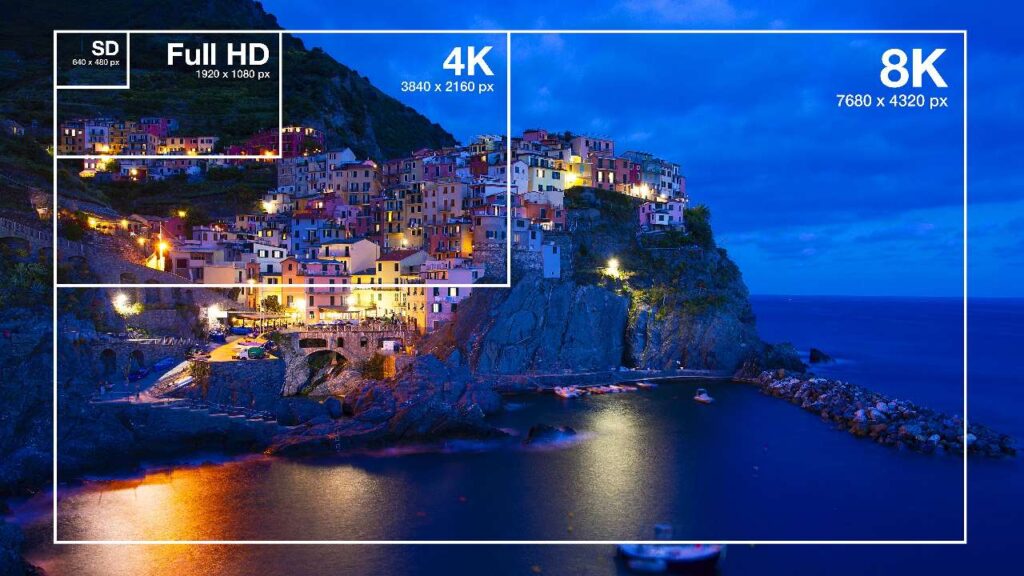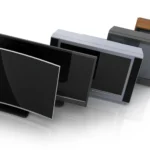Introduction
As television technology continues to evolve at a rapid pace, two terms have become increasingly prevalent in the market: 4K and 8K resolution. These high-definition standards promise to deliver stunning picture quality and enhanced viewing experiences, but what exactly do they mean, and how do they differ? In this comprehensive guide, we’ll explore the intricacies of 4K and 8K resolutions, compare their features, and help you understand which one might be the best choice for your needs.
The Basics of Resolution
Before diving into the specifics of 4K and 8K, it’s essential to understand the concept of resolution. In the context of television and display technology, resolution refers to the number of pixels that make up the image on the screen. Pixels are the tiny dots that combine to form the picture you see, and the more pixels there are, the sharper and more detailed the image will be.
Standard Definition (SD) and High Definition (HD)
Traditionally, televisions used standard definition (SD) resolutions, such as 480p (720×480 pixels) and 576p (720×576 pixels). With the advent of high definition (HD) technology, resolutions increased significantly, with common HD formats including 720p (1280×720 pixels) and 1080p (1920×1080 pixels).
Ultra High Definition (UHD)
4K and 8K resolutions fall under the category of Ultra High Definition (UHD). UHD represents a significant leap in pixel count and image quality compared to standard HD.
What is 4K Resolution?
Definition and Pixel Count
4K resolution, also known as Ultra HD or UHD-1, has a resolution of 3840×2160 pixels. This means that a 4K display has approximately 8.3 million pixels, four times the number of pixels found in a Full HD (1080p) display.
Aspect Ratio
Most 4K displays maintain the same 16:9 aspect ratio as standard HD televisions. This means that the width of the screen is 16 units for every 9 units of height, providing a widescreen viewing experience.
Benefits of 4K Resolution
- Enhanced Detail and Clarity: The increased pixel count in 4K resolution provides significantly sharper and more detailed images. This is particularly noticeable on larger screens, where the added pixels help maintain image quality.
- Improved Color and Contrast: Many 4K televisions come with advanced color and contrast technologies, such as High Dynamic Range (HDR), which enhance the overall viewing experience by delivering more vibrant colors and deeper blacks.
- Better Immersion: The high level of detail and clarity in 4K content can make the viewing experience more immersive, especially for movies, sports, and gaming.
- Future-Proofing: As more content is produced and broadcast in 4K, owning a 4K television ensures that you can enjoy the latest movies, shows, and games in the best possible quality.
4K Content Availability
The availability of 4K content has grown significantly in recent years. Streaming services like Netflix, Amazon Prime Video, and Disney+ offer a wide range of movies and TV shows in 4K resolution. Additionally, 4K Blu-ray discs and gaming consoles, such as the PlayStation 5 and Xbox Series X, support 4K playback.
What is 8K Resolution?
Definition and Pixel Count
8K resolution, also known as UHD-2, has a resolution of 7680×4320 pixels. This translates to an astonishing 33.2 million pixels, four times the number of pixels in a 4K display and sixteen times that of a Full HD display.

Aspect Ratio
Like 4K, 8K displays typically have a 16:9 aspect ratio, providing a widescreen viewing experience.
Benefits of 8K Resolution
- Unmatched Detail and Clarity: The sheer number of pixels in an 8K display results in incredibly sharp and detailed images, with a level of clarity that can reveal fine details even on very large screens.
- Enhanced Depth and Realism: The increased resolution can create a greater sense of depth and realism, making images appear more lifelike and immersive.
- Large Screen Performance: 8K resolution is particularly beneficial for very large screens, as the high pixel density ensures that image quality remains crisp and clear even at close viewing distances.
- Future Content: While 8K content is still relatively scarce, owning an 8K television can future-proof your home entertainment setup as more content becomes available in this resolution.
8K Content Availability
Currently, 8K content is limited compared to 4K. Some streaming platforms and video services are beginning to offer 8K content, and advancements in camera technology are enabling more filmmakers to produce 8K content. However, widespread adoption of 8K content is still in its early stages.
Comparing 4K and 8K Resolutions
Visual Quality
The primary difference between 4K and 8K is the number of pixels, which directly affects visual quality. While both resolutions offer excellent image quality, 8K provides a higher level of detail and clarity. On larger screens, this difference becomes more noticeable, with 8K delivering more lifelike and immersive visuals.
Content Availability
4K content is currently more widely available than 8K content. Many streaming services, Blu-ray discs, and gaming consoles support 4K resolution, whereas 8K content is still in the early stages of adoption. This means that, for now, 4K televisions offer more options for enjoying high-quality content.
Cost
8K televisions are generally more expensive than 4K televisions due to the advanced technology and higher pixel count. For consumers on a budget, 4K televisions provide an excellent balance of quality and affordability.
Practical Viewing Distances
The benefits of 8K resolution are most apparent on very large screens and at close viewing distances. For smaller screens or normal viewing distances, the difference between 4K and 8K may be less noticeable. This means that for many users, a 4K television may provide sufficient image quality without the need for the higher resolution of 8K.
Mobile Technology and High Resolutions
While 4K and 8K resolutions are most commonly associated with televisions, they are also relevant in the context of mobile technology. Smartphones, tablets, and laptops are increasingly featuring high-resolution displays, providing users with stunning visuals on portable devices.
4K and 8K on Mobile Devices
Many flagship smartphones and tablets now come with 4K displays, offering exceptional detail and clarity for watching videos, gaming, and browsing the web. Although 8K displays on mobile devices are less common, some high-end devices are beginning to explore this technology, promising even higher levels of detail.
Benefits for Mobile Users
- Enhanced Visual Experience: High-resolution displays on mobile devices provide sharper images and more vibrant colors, enhancing the overall user experience.
- Improved Gaming: Mobile gaming can benefit from higher resolutions, with more detailed graphics and smoother gameplay.
- Better Media Consumption: Watching videos and streaming content on high-resolution displays can be more enjoyable, with clearer images and more immersive visuals.
Challenges and Considerations
- Battery Life: High-resolution displays can consume more power, potentially impacting battery life. Manufacturers are continually working to optimize battery performance to balance resolution and power consumption.
- Content Scaling: Not all mobile content is optimized for 4K or 8K resolution. Some apps and videos may not take full advantage of the display’s capabilities, leading to scaling issues and less than optimal image quality.
The Future of High-Resolution Displays
Advances in Display Technology
As technology continues to advance, we can expect further improvements in display quality and resolution. Innovations such as MicroLED and MiniLED technology are enhancing brightness, contrast, and color accuracy, further elevating the viewing experience.
The Role of AI and Machine Learning
Artificial intelligence (AI) and machine learning are playing a significant role in advancing display technology. AI-driven upscaling techniques can improve the quality of lower-resolution content, making it look better on 4K and 8K displays. These technologies are continually evolving, promising even better performance in the future.
Content Production and Distribution
The production and distribution of high-resolution content are also evolving. As more filmmakers and content creators embrace 4K and 8K technology, the availability of high-quality content will continue to grow. Advances in compression techniques and network infrastructure will make it easier to stream and download large files, ensuring that users can enjoy high-resolution content without buffering or delays.
Consumer Adoption
Consumer adoption of 4K and 8K technology is expected to increase as prices continue to decrease and content availability expands. Early adopters and tech enthusiasts are already driving demand, and as more consumers experience the benefits of high-resolution displays, the market for 4K and 8K televisions and mobile devices will continue to grow.
Conclusion
Understanding the differences between 4K and 8K resolutions is essential for making informed decisions about your next television or mobile device purchase. While both resolutions offer stunning image quality, the choice between 4K and 8K depends on various factors, including screen size, viewing distance, content availability, and budget.
4K resolution provides a significant upgrade over standard HD, offering enhanced detail, color, and contrast. It is widely supported by streaming services, gaming consoles, and media players, making it a practical choice for most consumers.



